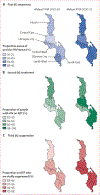Trends in HIV prevalence, incidence, and progress towards the UNAIDS 95-95-95 targets in Malawi among individuals aged 15-64 years: population-based HIV impact assessments, 2015-16 and 2020-21
- PMID: 37586390
- PMCID: PMC10542580
- DOI: 10.1016/S2352-3018(23)00144-3
Trends in HIV prevalence, incidence, and progress towards the UNAIDS 95-95-95 targets in Malawi among individuals aged 15-64 years: population-based HIV impact assessments, 2015-16 and 2020-21
Abstract
Background: In 2014, UNAIDS set the goal of ending the AIDS epidemic by 2030 through the achievement of testing and treatment cascade targets. To evaluate progress achieved and highlight persisting gaps in HIV epidemic control in Malawi, we aimed to compare key indicators (prevalence, incidence, viral load suppression, and UNAIDS 95-95-95 targets) from the 2015-16 and 2020-21 Malawi Population-based HIV Impact Assessment (PHIA) survey results.
Methods: The Malawi PHIAs were nationally representative, cross-sectional surveys with a two-stage cluster sampling design. The first survey was conducted between Nov 27, 2015, and Aug 26, 2016; the second survey was conducted between Jan 15, 2020, and April 26, 2021. Our analysis included survey participants aged 15-64 years. Participants were interviewed and a 14 mL blood sample was collected and tested for HIV infection using the national rapid testing algorithm. For each survey, we estimated key HIV epidemic indicators and achievement of 95-95-95 targets. The risk ratio (RR) of the indicators between surveys were computed and considered significant at a confidence level of 0·05. All results were weighted, and self-reported awareness and treatment status were adjusted to account for detection of antiretrovirals.
Findings: Our analysis included 17 187 participants aged 15-64 years in 2015-16 and 21 208 in 2020-21 who participated in the surveys and blood draw. In the 2020-21 survey, 88·4% (95% CI 86·7-90·0) of people living with HIV were aware of their HIV-positive status; of those aware, 97·8% (97·1-98·5) were on antiretroviral therapy; and of those on treatment, 96·9% (95·9-97·7) were virally suppressed. Between surveys, the national HIV prevalence decreased significantly from 10·6% (10·0-11·2) to 8·9% (8·4-9·5) with RR 0·85 (95% CI 0·78-0·92; p<0·0001). The annual HIV incidence decreased from 0·37% (0·20-0·53) to 0·22% (0·11-0·34) with RR 0·61 (95% CI 0·31-1·20; p=0·15). The population viral load suppression increased from 68·3% (66·0-70·7) in 2015-16 to 87·0% (85·3-88·5) in 2020-21 (RR 1·27 [95% CI 1·22-1·32]; p<0·0001).
Interpretation: These results suggest that Malawi had already surpassed the UNAIDS viral load suppression target for 2030 (85·7%) by 2020-21. Through strategies and evidence-informed interventions implemented in the last half decade, especially scale-up of effective HIV treatment, Malawi has made tremendous progress, including decreasing HIV prevalence and incidence and achieving both the second and third 95 targets ahead of 2030. To address the first 95, efforts in HIV diagnosis should focus on males and younger age groups. There is a continued need for effective linkage to care, retention on antiretroviral therapy, and adherence support to maintain and build on progress.
Funding: US President's Emergency Plan for AIDS Relief through the US Centers for Disease Control and Prevention.
Copyright © 2023 Elsevier Ltd. All rights reserved.
Conflict of interest statement
Declaration of interests We declare no competing interests.
Figures


Comment in
-
Malawi HIV progress: persistence and innovation are needed.Lancet HIV. 2023 Sep;10(9):e562-e563. doi: 10.1016/S2352-3018(23)00181-9. Epub 2023 Aug 13. Lancet HIV. 2023. PMID: 37586391 No abstract available.
References
-
- UNAIDS. 90–90–90: an ambitious treatment target to help end the AIDS epidemic https://www.unaids.org/sites/default/files/media_asset/90-90-90_en.pdf (accessed Feb 7, 2022).
-
- UNAIDS. Understanding fast-track: accelerating action to end the AIDS epidemic by 2030 https://www.unaids.org/sites/default/files/media_asset/JC2686_WAD2014rep... (accessed March 23, 2023).
Publication types
MeSH terms
Grants and funding
LinkOut - more resources
Full Text Sources
Medical
Miscellaneous

